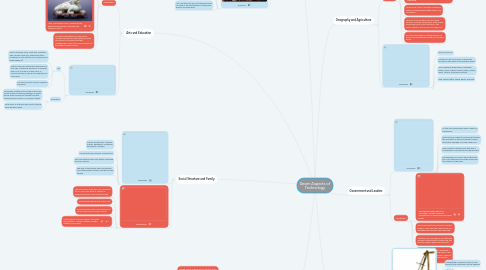
1. Religion
1.1. Shang/Zhou
1.1.1. Shang people believed that God dominates the world. They also worshipped their ancestors, the sun, the moon, the river, and the earth and sacrifice ceremonies were typically grand events.
1.1.2. The art of fortune telling was popular during this time.
1.1.3. Folk Religion during the shang dynasty was Polytheistic
1.1.4. The Shang grew millet, wheat, rice, and barley as food. This ritual bronze cup held wines made from rice and millet. Wine and grains were offered as sacrifices in bronze ritual cups to the gods of the harvest
1.2. Sumerian
1.2.1. One of the oldest known cities, Uruk, was dedicated to Innana, the patron goddess of their city
1.2.2. The Sumerian religion was polytheistic and worshiped a great number of anthropomorphic deities
1.2.3. The deities represented the natural forces of the world
1.2.4. "An" was the first and most powerful god. He lived in the sky/heavens and granted powers to other gods
2. Arts and Education
2.1. Shang/Zhou
2.1.1. Improvements in bronze casting techniques allowed them to make musical instruments, such as an ocarina, drums and copper cymbals.
2.1.2. To date, the Shang dynasty is the earliest period in China for which textual and archaeological evidence both exist
2.1.3. Jade, along with bronze, represents the highest achievement of Bronze Age material culture.
2.1.4. Current knowledge about the Shang dynasty derives from later historical texts, excavations of tombs and other archaeological sites, and Shang divinations inscribed on oracle bones.
2.2. Sumerian
2.2.1. Art
2.2.1.1. Most commonly form of art was sculpture. They usually used clay, which gave their sculptures a soft look (since it is hard to put sharp edges in)
2.2.1.2. When a piece of writing was finished on a clay slab, Sumerians would roll a "cylinder seal" on it to mark it as their own. In current day this is similar to a signature on your work.
2.2.1.3. Art was primarily used for religious purposes
2.2.2. Education
2.2.2.1. Sumerians created some of the first known formal schools in which a teacher or priest would teach cuneiform (writing) and the students would copy on a different tablet
2.2.2.2. Took place in a temple and most students were wealthy males
3. Social Structure and Family
3.1. Sumerians
3.1.1. Overall divided into 4 groups. Priests, pheasants, craftsmen, and warrior-soldiers.
3.1.2. Community was ruled by a priesthood.
3.1.3. The communities were city states organized around a temple.
3.1.4. The bulk of the people were considered to be the servant-slaves of the god of the temple.
3.2. Shang/Zhou
3.2.1. The aristocracy were the most respected social class, they were in charge of governing smaller areas of the dynasty.
3.2.2. Farmers were the largest social class
3.2.3. Women played a very important role in society during the Shang Dynasty.
3.2.4. Classified into 4 social classes. The King and Relatives, Nobles, Artisans, Traders, Farmers, and Slaves.
4. Economy and Trade
4.1. Shang/Zhou
4.1.1. Fishing began to grow as an industry as the people fished in the fresh waters.
4.1.2. Many Shang writings on bronze refer to cowrie shells as a form of money.
4.1.3. Economy of Zhou Dynasty was based on agriculture.
4.1.4. Cowrie shells were used as currency
4.2. Sumerians
4.2.1. Jobs included pottery makers, stonecutters, bricklayers, metal smiths, farmers, fishers, shepherds, weavers, leather-workers, and sailors.
4.2.2. Practiced trading in their original homeland, Dilmun.
4.2.3. Economy was based on agriculture
5. Geography and Agriculture
5.1. Shang/Zhou
5.1.1. Core area in the middle course of the Yellow River, in the middle province of Henan and in the Western part of Shandong.
5.1.2. Yellow River Valley had water and good fertile soil which helped them thrive as a civilization.
5.1.3. Farmers in the northern area of Shang territory, near the Yellow River, grew mainly wheat and millet. Some farmers in the region south of the Yellow River grew rice.
5.1.4. was able to prosper off the abundance of loess, a fertile sediment found on the river's banks.
5.2. Sumerians
5.2.1. about 4000 B.C.
5.2.2. Located on the flood plain of the lower reaches of the Tigris and Euphrates Rivers
5.2.3. The Sumerians grew barley, chickpeas, lentils, millet, wheat, turnips, dates, onions, garlic, lettuce, leeks and mustard.
5.2.4. They raised cattle, sheep, goats, and pigs
6. Government and Leaders
6.1. Sumerians
6.1.1. At first the communities were ruled by a priesthood.
6.1.2. Later warriors ruled the community (usually the strongest as the commander), which eventually changed to a king under rule.
6.1.3. They created a government that was a combination of monarchy and democracy
6.1.4. The kingdoms of Sumer were organized into city-states and the Kings ruled each city-states for the gods
6.2. Shang/Zhou
6.2.1. The king had many jobs in his civilization. He also served as commander for large armies and chief priest.
6.2.2. The government also had many levels of leaders. The closer they were to the king, the higher the position they deserved.
6.2.3. Vassals could rule areas of land but they needed to pay tributes to their king and provide soldiers when war broke out.
6.2.4. The Shang Dynasty had a monarchy government. The king had most of the power and enforced the laws. The king wasn't responsible for just political issues.
7. Science and Technology
7.1. Sumerians
7.1.1. Writing (the cuneiform script on clay tablets) and systematic record keeping
7.1.2. The plow
7.1.3. Social and economic organization
7.1.4. Units of time (the division of a day into 24 hours and one hour into 60 minutes)
7.2. Shang/Zhou
7.2.1. Oracle Scripts contain records about solar and lunar eclipses, stars and other celestial happenings.
7.2.2. The calendar system continued to advance and in the area of math,
7.2.3. Iron-tipped oxdrawn plows improved irrigation techniques. Increased irrigation led to increase in the agricultural abundance of food, which in turn increased the population.
7.2.4. The earliest writings were inscripted on bones and shells-called "oracle bones"-recorded divination used by the Shang royal house.
